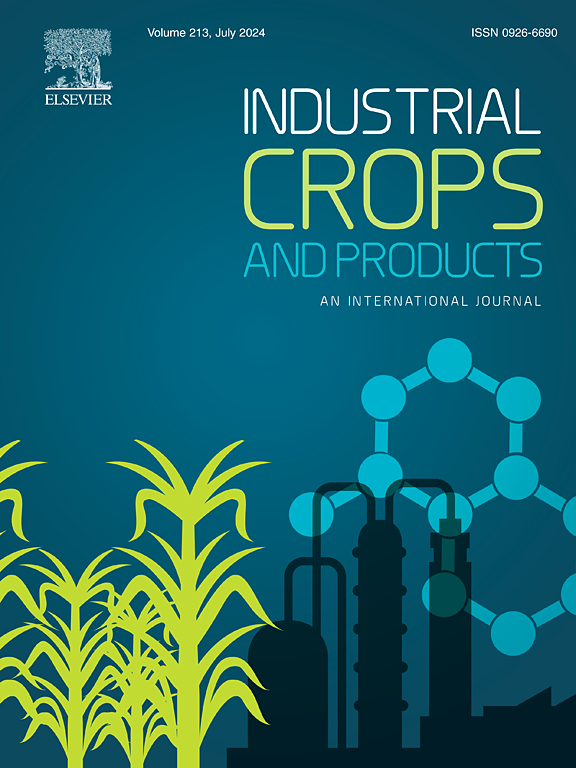发光二极管(led)和水分亏缺对马蹄草植物化学、生理和形态的影响
IF 6.2
1区 农林科学
Q1 AGRICULTURAL ENGINEERING
引用次数: 0
摘要
研究了不同发光二极管(led)对不同灌溉制度下牛膝草(Hyssopus officinalis L.)形态、生理生化特性的影响。试验采用完全随机设计,重复3次。不同处理包括温室自然光(C)、100 %白光(W)、100 %红光(R)、100 %蓝光(B)和75 %红光+ 25 %蓝光(RB)。本研究还采用90 %田容量灌水(对照)和70 %田容量灌水(低灌)两个水平。结果表明:与对照灌水相比,低灌水导致幼苗干、湿重、冠层面积和相对含水量降低;低灌水量条件下,光合色素和大部分生理性状均增加,电解质泄漏(EL)增加。在不同的LED光谱中,r光和b光分别表现出最高的茎长和叶宽。与其他光谱相比,低灌水条件下rb光增强了大部分研究性状,如发育和生理性状以及挥发油率。与c光相比,rb光显著提高了黄酮类和酚类含量,分别提高了92 %和121 %,挥发油含量提高了2.5倍。GC-MS分析结果显示,3-蒎酮、石竹烯、微生物烯- d、石竹烯是其含量最高的成分。Elemol在强光条件下含量最高(45 %)。RB-light可以提高植物对低灌水量的抗性,改善植物的生产性能,增加植物精油的产量。本文章由计算机程序翻译,如有差异,请以英文原文为准。
Phytochemical, physiological and morphological alterations in Hyssopus officinalis L. as affected by light emitting diodes (LEDs) and water deficit
In this study the effect of different light emitting diodes (LEDs) was investigated on the morphological, physiological, and biochemical characteristics of hyssop (Hyssopus officinalis L.) under different irrigation regiems. The experiment was performed in a completely randomized design with three replications. The different treatments included the natural light of the greenhouse (C), 100 % white (W), 100 % red (R), 100 % blue (B), and 75 % red + 25 % blue light (RB). Two levels of 90 % field capacity irrigation (control) and 70 % field capacity irrigation (low irrigation) were also used in this research. The results indicated that low irrigation led to a reduction in the wet and dry weight of shoots, canopy area, and relative water content (RWC) as compared with control irrigation. Photosynthetic pigments and most of the physiological traits, along with electrolyte leakage (EL), increased under low irrigation. Among various LED light spectra, R-light and B-light exhibited the highest shoot length and leaf width, respectively. The RB-light enhanced most of the investigated traits, such as developmental and physiological traits, and the percentage of essential oil under low irrigation compared with other light spectra. The RB-light significantly increased phenol and flavonoid content by 92 % and 121 %, respectively, compared with C-light and resulted in a 2.5 times increase in essential oil percentage. Based on GC-MS analysis, 3-pinanone, caryophyllene, germacrene-D, elemol were the most abundant components. Elemol showed the highest amount (45 %) in RB-light condition. It appears that the RB-light could elevate plant resistance to low irrigation, improve plant performance, and increase the plant essential oil production.
求助全文
通过发布文献求助,成功后即可免费获取论文全文。
去求助
来源期刊

Industrial Crops and Products
农林科学-农业工程
CiteScore
9.50
自引率
8.50%
发文量
1518
审稿时长
43 days
期刊介绍:
Industrial Crops and Products is an International Journal publishing academic and industrial research on industrial (defined as non-food/non-feed) crops and products. Papers concern both crop-oriented and bio-based materials from crops-oriented research, and should be of interest to an international audience, hypothesis driven, and where comparisons are made statistics performed.
 求助内容:
求助内容: 应助结果提醒方式:
应助结果提醒方式:


